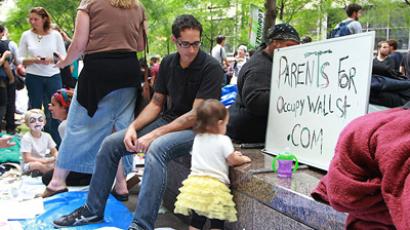The Occupied Wall Street Journal – news from the revolution
As some mainstream media networks continue bashing the Occupy Wall Street protests, the movement publishes its own newspaper at a secret location. RT takes a sneak peek into what the Journal is all about.
Every revolution has a manifesto. Occupy Wall Street does not – yet. What they do have is the Occupied Wall Street Journal. Attracting readers from all walks of life like bees to honey, the newspaper documents the story of the occupation in the words of those out on the streets calling for change in the US.“I think it's a very good idea and I think it's a wonderful movement, and I can concur with a lot of their ideas,” said retired teacher Judy Fineman, holding the newspaper. “It's offered by the people here, so I figure it's probably the best source,” said protester Jessica Morabito.The paper doesn’t rely on advertising, like most others now in decline. $75,000 in donations were raised in a blink of an eye to start up the project. Context of the revolution, thoughtful articles and practical information on getting involved fill its pages.“People reading this in subways, in parks, on streets, older people, people who are curious, who heard – there's a lot of noise being heard at Wall Street, what's this all about? You need words that are in print that shock and make the reader think,” said managing editor of The Occupied Wall Street Journal Michael Levitin.A volunteer group runs the paper at a secret location. Among them, Levitin, a former freelance reporter for Newsweek, the LA Times and the Associated Press.“It was essential to get something into people's hands that they could pass, share, distribute. It was a tactile visual not embodiment, but representation of what's happening in the square, that isn't being told by the mainstream media,” he said. The newspaper, as well as the revolution, were inspired by the Arab Spring.“This is fundamentally an outgrowth of events that happened in North Africa in the Arab-speaking world this year. 2011 has been an incredible year,” said Michael Levitin. The paper’s publisher, Jed Brandt, echoed this. “If the Mubarak regime can fall, this regime can fall,” said Brandt. He believes The Occupied Wall Street Journal has electrified Americans of all ages and backgrounds. “What most Americans believe is not allowed on television. They have the same commentators telling us the same issues over and over, pointing fingers, telling us who to hate and fear. We need to provide something for the people all across the country that encourages them to participate,” said Brandt. This seems to have worked for Troy Moslemi, who was once homeless. “I am a law partner. Four years ago, I was really collecting pennies for a hamburger at McDonalds and I can't forget that,” he said. “I wanted to come down and see what was going on, so I picked up the newspaper, listening, reading, seeing why people are here,” said laid-off bank worker Bryson Lord.50,000 copies of the first edition were gone within two days. So were the 100,000 copies of the second one.From tens of thousands of issues to hundreds of thousands – The Occupied Wall Street Journal has plans to go national in the days to come. From an underground broadsheet put together in the big apple, to a source of news to be spread all across the US.














